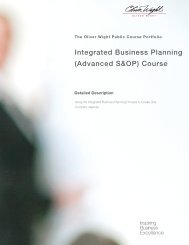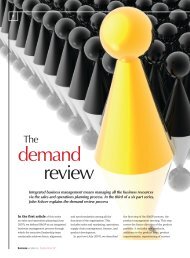Demand Planning Article: Getting ready for change - Oliver Wight ...
Demand Planning Article: Getting ready for change - Oliver Wight ...
Demand Planning Article: Getting ready for change - Oliver Wight ...
Create successful ePaper yourself
Turn your PDF publications into a flip-book with our unique Google optimized e-Paper software.
S t r a t e g i c m a n a g e m e n t : D e m a n d p l a n n i n g 3Organizational placement: Increaseyour chances of success. The optimalplacement of demand planning is withinmarketing and sales, as the demandplan is theirs to commit to and execute.Placement in other organizations canwork but can obscure the accountabilityof marketing and sales <strong>for</strong> the planand risk other sorts of bias. For thegreatest likelihood of the success ofdemand planning in generating cash,maintaining margins, and gainingshare, put it in marketing or sales.Accountabilities: Holding people totheir commitments is essential. Howoften I have heard the complaint,“People are not held accountablearound here.” To run a process to itsfull per<strong>for</strong>mance capability, or saidanother way, to get people to theirmaximum capability, which is whatskilling up is all about, organizationaland personal accountabilities mustbe crystal clear, measured, and haveconsequences. This should not soundthreatening to an organization inwhich competent people are in rolessuited to them, with adequate toolsand resources to do their work, andwhere measurements are used tounderstand and improve per<strong>for</strong>mance.Behaviors: Culture shift may benecessary. <strong>Demand</strong> planning is acollaborative process, involving avariety of viewpoints, and dependentupon timely and accurate in<strong>for</strong>mation<strong>for</strong> its effectiveness. Essential culturalbehaviors <strong>for</strong> demand planning successinclude trust, openness and honesty,and secondarily, a cultural mentalitythat embraces and values flexibility,<strong>change</strong>, preparation, measurement<strong>for</strong> improvement, management byexception, and learning.The role of executive leadershipThe role of the chief executive andmarketing and sales leadership inthe context of demand planning isto craft the vision and define thecultural shift, illustrate by example,and demonstrate by leading the<strong>change</strong>. As the head goes, the bodywill follow. This is not somethingthat can be delegated. Marketing andsales leadership have accountability“The executive must not only be in love withthe outcome of the process, but love owningand leading the process”<strong>for</strong> demand planning and must ownand lead it.Here is a five-point plan <strong>for</strong>executive leadership:1. Set the vision challenge <strong>for</strong> demandplanning. Define the expectations youhave. Make them specific and real:revenue, net income, margin, earningsper share, working capital. Describethe cultural behaviors. Write the visiondown. Post it on the walls.2. Communicate, communicate,communicate. Speak directly to the peopleabout your vision and expectations.Cascade the communication. Be carefulnot to sabotage yourself by your ownactions, which will be watched closely.3. Educate, educate, educate. Educationis undervalued and underutilized today.Do not skimp on time and resources todevelop understanding and competency.Your payback period will be a few shortmonths.4. Engage. I like the way a colleagueputs it: “The executive must not onlybe in love with the outcome of theprocess, but love owning and leadingthe process.” Engage yourself andrequire the engagement of others.Rein<strong>for</strong>ce behaviors. Do not acceptnon-compliance.5. Incent behaviors that get desiredresults. When you start using thedemand plan as a dynamic, agileway to shape future demand, youneed to incorporate demand planper<strong>for</strong>mance and related metrics intoyour incentive system.<strong>Getting</strong> at the cash-rich benefitsof high-per<strong>for</strong>ming demand planningis not difficult, given executiveleadership and engagement, and awilling, capable organization. Whatcan be more fundamental to executiveleadership’s role than creating thisorganizational environment?SummaryWhen demand planning is taken tothe level of excellence needed to putyou on top of your game and positionyour company <strong>for</strong> compoundedsuccess coming out of the recession,you must take a close look at thepreparedness of your people andthe suitability of the environmentin which they work. Otherwiseprocess excellence is an exercisein futility. Different competenciesand behaviors will be required.Executives must create the vision,accept accountability, directly engagein and lead the <strong>change</strong>.Part 4 will discuss the finalfundamental move to regain the moneytrail: integration, and alignment of thedemand planning process with otherbusiness processes.Susan L. Storch is a principal with <strong>Oliver</strong> <strong>Wight</strong> Americas. She is recognizedas a leading expert in demand planning and <strong>change</strong> management, the twogoing very much hand in hand. Susan’s experience spans thirteen yearswith <strong>Oliver</strong> <strong>Wight</strong> and twenty years of executive management positions inindustrial, CPG, and service sectors. Susan has led and coached manybusinesses to Class A business excellence certification.August 09 www.bus-ex.com 11
















